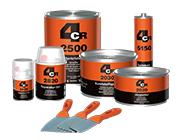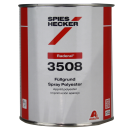Bodywork putty: type, surface, application, repair, finish

Car body Putty
︾
Choosing the right bodywork putty for your car :
The new putties offer greater ease of application, with optimised filling power to cover bodywork imperfections. Thanks to their improved formula, they spread easily and adhere perfectly to the surface, guaranteeing long-lasting results.
What's more, some putties are reinforced with specific pigments to blend in better with the paint, ensuring a perfect finish. To get the best results, it's crucial to choose a product that's appropriate for the category of material being treated.
The best bodywork putty is one that offers good filling power and is easy to apply, guaranteeing effective, long-lasting repairs on all types of vehicle.
Everything you need to know about using bodywork putty:
Using a bodywork putty is an important step in the process of repairing imperfections and defects on a vehicle's bodywork. Body putties are versatile compounds used on aluminium or steel surfaces. They offer protection against theappearance of defects thanks to their fine, elastic composition. Their density and elasticity make them suitable for areas subject to vibration, ensuring a durable finish. There are different types of Putty, composed to suit the weight and specific characteristics of the materials, guaranteeing easy application and a uniform texture.
Steps for using a bodywork putty :
1. Prepare the surface:
Start by thoroughly cleaning the area to be repaired using a bodywork degreaser cleaner. Make sure the surface is free of dirt, grease and contaminants.
2. Identify defects:
Identify any scratches, dents, dings or other imperfections on the bodywork. Mark them if necessary.
3. Sanding the area:
Use sandpaper to lightly sand the area around the defects. This creates a rough surface that improves the adhesion of the Putty.
4. Mixing the bodywork putty:
If the putty requires a Hardener, mix it in the proportions recommended by the manufacturer. Be sure to mix thoroughly to obtain a homogeneous consistency.
5. Applying Putty:
Use a putty spatula to apply an even layer of putty to the area to be repaired. Work the Putty into the defects while smoothing the surface.
6. Curing the bodywork putty :
Allow the Putty to harden according to the drying time indicated. Curing time may vary depending on the type of Putty and environmental conditions.
7. Sanding hardened Putty :
Once the Putty has cured, use abrasive paper to sand the surface. The aim is to shape the Putty to match the shape of the surrounding bodywork.
8. Cleaning the area:
Clean the repaired area with a cloth or paper towel to remove sanding dust.
9. Checking the quality of the repair :
Assess the surface to ensure that the repair is satisfactory. If necessary, repeat the Putty application and Sanding steps.
10. Primer (if necessary):
If you are preparing the bodywork for subsequent painting, apply a coat of primer in accordance with the recommendations.
Why use putty?
Using a Putty is an essential step in the process of preparing a vehicle's bodywork for painting.
1. Correcting imperfections :
Putty is mainly used to correct imperfections and surface defects such as scratches, dents, cracks, holes and other irregularities. It restores the surface to a smooth, even condition.
2. Surface preparation :
Before applying a new coat of Paint, it is crucial to have a perfectly prepared surface. It fills in small defects and creates a solid, even base for optimum paint adhesion.
3. Improved adhesion :
By filling in hollows and cracks, Putty creates a flat surface that improves the adhesion of new paint. This helps to ensure that the paint adheres evenly and permanently to the bodywork.
4. Surface levelling :
These are used to adjust differences in level between repaired areas and intact parts of the bodywork. This is particularly important to achieve an aesthetically pleasing and professional finish.
5. Structural reinforcement :
Some types, such as Fiberglass, offer additional structural strength. They are used to reinforce damaged areas and ensure the strength of the bodywork.
6. Ease of repair:
They make it easier to repair minor damage such as paint chips, scratches and light impacts. They offer an effective solution for restoring the vehicle's appearance without having to replace entire parts.
7. Saves time and money:
By allowing localised touch-ups rather than the complete replacement of panels, body putty can save time and money in the vehicle restoration process.
The different types of body putty:
Preparing a car body for paint often requires the use of specific putties. Here's an exploration of the different types and their specific characteristics:
Fiberglass :
Contains Fiberglass for added strength. Ideal for touch-ups requiring structural strength, such as holes, cracks and metal surfaces.
Metal:
Formulated to adhere strongly to metal surfaces. Suitable for repairs to metal body panels, often used to fill weld areas or metal imperfections.
Pistolable :
Packaged in cartridges for application by spray gun. Facilitates application and is suitable for major repairs or jobs requiring large quantities.
Plastic:
Designed to adhere to plastics. Suitable for repairs to plastic parts such as bumpers and trim.
Sprayable:
Can be applied with a spray gun. Facilitates application over large areas, often used for bodywork repairs requiring a smooth finish.
Polyester :
Mainly made from polyester resin. Used for repairing Fiberglass parts, bonding surfaces or as a primer.
Wedges and Spatulas:
Used to apply and shape the Putty. Wedges help spread the Putty evenly, while spatulas smooth and shape the surface.
Choosing the right type of putty depends on the nature of the repair, the bodywork material and the preferences of the professional or amateur. It is essential to follow the instructions to ensure correct application and long-lasting results.
Your questions about Putty :
1. What type of bodywork putty should I use for my car repairs?
The choice of putty depends on the bodywork material and the type of repair. Options include Fiberglass putty, metal putty, plastic putty, etc.
2. Do I need to prepare the surface before applying Putty?
Yes, it is essential to prepare the surface by cleaning, degreasing and, if necessary, lightly sanding to ensure optimum adhesion of the putty.
3. What's the difference between spray putty and conventional putty?
Spray putty is packaged in cartridges for application by spray gun, offering greater convenience for major repairs. Conventional putty often comes in a pot and is applied with a spatula.
4. Can I use the same Putty for metal and plastic surfaces?
Some putties are versatile, but we recommend using a putty specific to the bodywork material to ensure optimum adhesion.
5. When should I use polyester putty?
Polyester putty is often used to fill imperfections, cracks and holes, offering particularly good adhesion to metals and plastics.
6. How do I apply bodywork putty evenly?
Use suitable spacers and spatulas to spread the Putty evenly. Work in small areas and smooth the surface while the Putty is still malleable.
7. Does bodywork putty need to be sanded after hardening?
Yes, sanding hardened Putty is often necessary to obtain a smooth surface and eliminate irregularities. Use fine abrasive paper for this step.
8. How long does it take for body Putty to dry completely?
Drying time varies according to the type of product and environmental conditions. Always follow the manufacturer's recommendations, which indicate the time required for complete curing.
9. Does body putty require priming before painting?
In many cases, the application of a coat of primer after the Putty has hardened is recommended to improve the adhesion of the paint.
10. How can I avoid air bubbles?
Avoid mixing the filler too vigorously to prevent air from entering. Apply it evenly and avoid sudden movements that could trap air.
Using body putty can raise a number of issues, but by understanding the specific needs of each project and following the manufacturer's instructions, users can achieve professional, long-lasting repair results.
Top brands available on the Carross website:
We offer many leading brands of body filler on the Carross website, you an overview of the technical specifications:
4CR :
The 4CR brand is renowned for its car repair solutions, offering a complete range of bodywork putties. These high-quality products are designed to meet the requirements of bodywork professionals, offering reliable performance when repairing defects.
Carross :
Carross is a brand renowned for its bodywork preparation and finishing products. Carross putties are formulated with a focus on quality, offering solutions for a variety of repairs, from filling imperfections to creating smooth surfaces prior to paint.
Cromax:
Bodywork putties from Cromax, a brand belonging to the Axalta Group, are renowned for their advanced technology and compatibility with Cromax paint systems. They offer reliable adhesion, ease of application and help achieve aesthetically pleasing, long-lasting repairs.
Glasurit:
As a premium paint brand, Glasurit also offers quality bodywork putties. These products are designed to ensure thorough preparation before painting, contributing to exceptional final results in terms of adhesion and finish.
MaxMeyer:
Putties from MaxMeyer, a PPG Group brand, are valued for their consistent performance. They are often used to fill defects, cracks and holes on bodywork, providing a solid base for subsequent paint application.
Mobihel:
Mobihel offers a range of putties to a variety of repair needs. These products are designed to offer optimum adhesion, ease of application and compatibility with Mobihel paint systems, ensuring professional quality results.
Spies Hecker:
Putties from Spies Hecker are renowned for their excellence in preparation. They offer exceptional adhesion, making it easy for bodywork professionals to achieve impeccable, long-lasting results.
Standox :
Standox offers innovative putties designed to meet the high demands of automotive paint shops. These products contribute to precise bodywork preparation, ensuring optimum paint adhesion and a high-quality finish.
By choosing putties from reputable brands such as 4CR, Carross, Cromax, Glasurit, MaxMeyer, Mobihel, Spies Hecker and Standox, professionals can be confident in the quality of the products, making it easier to carry out aesthetic and long-lasting repairs to vehicles. It is advisable to follow the manufacturer's specific instructions to maximise the effectiveness and durability of the putties.
